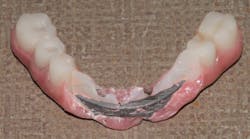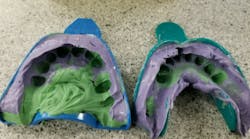Making the switch to electronic dental records
November 13, 2012
Except maybe your peers in the industry.
“For offices that are providing Medicaid services, if they’re not paperless by the end of 2014, they’ll see a drop in their reimbursement,” said Dr. Lorne Lavine ofThe Digital Dentist. “There’s absolutely nothing out there that says practices must be digital by 2014, but a lot of people have taken that Medicaid reimbursement and turned it around.”
So why are practices feeling the push to go digital with their patient records? “There are a lot of advantages of being digital, and so there’s a lot of peer pressure to go digital,” explained Dr. Lavine. “I estimate that about half of practices are digital with their X-rays right now.”
According to the ADA Primer on electronic health records, in 2006, 90% of dentists used some form of practice management software. That same year, 47% of new dentists and 42% of established dentists claimed their offices were at least somewhat paperless.
The move to digital is happening right now: new software is being developed, more practices are implementing the systems that are currently out there, and paper is becoming an archaic form of how we document and communicate. Here’s what you need to know before you make the move to implement an EDR in your practice.
The shortcomings of early EDRs
After the devastation caused by Superstorm Sandy on residents in its path – including dentists and their practices – the concern for protecting information, communicating with patients, and getting business back to normal as soon as possible became more prevalent.
Consider these statistics from Liptak Dental:
- 60% of companies that lose their data will shut down within 6 months of the disaster
- 93% of companies that lost their data for 10 days or more filed for bankruptcy within one year
- 50% of businesses that found themselves without data management for this same time period filed for bankruptcy immediately
You may be encouraged to make the switch to electronic records, but there are still some obstacles in the way to an ideal system. “The problem in dentistry is that there aren’t a lot of systems that would qualify as true EHRs. Most of the packages that are out there qualify on some levels, but I really can’t think of any that meet all of the qualifications of EHRs,” explained Dr. Lavine.
The qualifications he mentioned include the ability to be completely paperless, do all communication electronically, and meet HIPAA and HITECH compliances. “A lot of the systems can get you part of the way there. Where they fall short are when you need signatures for things like patient forms, claims, lab slips – a lot of the programs don’t have that built in.” Though Dr. Lavine doesn’t believe that there is one system that offers a “true EHR,” there are some that come close, such as Carestream’s WinOMS CS.
Carestream Dental partners with Amazing Charts on EHR solution
Since there is no perfect, do-all system yet, there are some gaps that need to be filled. Dentists, says Dr. Lavine, are going to have to “piecemeal it together.”
“You’re going to have practice management software, but you’ll have another company handle your images.”
Cloud-based EDRs
Cloud-based EDRs are a safe option if you are worried about the physical integrity of your office. Natural disasters can leave you with nothing left after years of documentation and record-keeping. But if your information is backed up and kept online, it’s protected – no matter what happens to your office.
“Cloud-based companies have been touting the advantages of cloud for years, which most people are well aware of. You don’t have to worry about backing up your data or being HIPAA compliant, you can access it from anywhere, and you don’t need high-end computers because you’re accessing through a browser.”
Though the advantages of cloud-based EDRs are clear, there are some issues that you should consider. The first, says Dr. Lavine, is the reliability of your Internet connection. “If you’re in a remote area, it’s not all that easy.”
The other concern is that the cloud-based systems are just so new that all of the kinks are still being worked out. “In my opinion, because the EDR software is so critical to running the practice, you’d have to evaluate that program just as you would with any other software. The concern with the cloud-based EDRs is that they’re relatively new. They’re getting better every day – they’re updating their software, they’re getting to the point where they’re a viable option – but they’re still not completely developed.”
It’s good to know about the “gaps” going in. Even if the products are a bit underdeveloped so far, they might be capable of doing all that you need. After all, according to Dr. Lavine, the typical dental practice only uses about 5% of what their software can do.
UOR workshop: Connecting flight, electronic health records
If you’re worried about putting your personal information on the worldwide web, remember that the information you store in cloud-based EDRs is highly protected. Consider the HIPAA and HITECH guidelines that your system has to comply with: cloud-based systems, like Liptak DDS Rescue and Patterson Eaglesoft Clinician, have encryption levels that are more secure than what you have for your physical documents.
Still have trust issues? Get to know the company behind the product you’re considering.
“You can look the company up online,” advises Dr. Lavine. “HIPAA requires so many things from both an encryption stand point and a protection of the physical – HIPAA suggests that a server should be under lock and key and that you change the passwords frequently. … It’s not something that I worry about too much because the ones we deal with in dentistry are absolutely HIPAA compliant, whereas dentists by themselves aren’t as compliant as the cloud-based systems – they just don’t have the resources.”
Client server-based EDRs
Fine, you’re old fashioned. Old dog, new tricks, that whole thing. You’re just not comfortable having your data floating around in some cloud. Luckily, there is another option: client server-based EDRs. These are systems that do back-ups on your own computers. They sit in your office and they’re protected by the same locks that protect your dental equipment. They’re nearby, accessible, and your information doesn’t have to travel outside of your office to be protected.
There is no “better” option, according to the Dr. Lavine – so it just depends on what you’re comfortable with and what works for you. What you should do, he advises, is test the product just as you would any other dental product that piqued your interest.
The hybrid
If you’re uncomfortable with the cloud for your data but you don’t like the idea of having your back-up sitting right beside the computers you work on every day, you have a third option. You can rent space on servers from companies that offer EDRs.
“It’s not cloud-based, but you’re storing your software and data on another server. You would be exempt from the data backup and the HIPAA requirements. The problem is, you can’t use a system like that for digital X-rays – it’s way too slow.”
What would it take for my practice to go paperless?
Interoperability
One thing you should keep in mind is that no EDR offers interoperability at this point – something that medical EHRs have already offered. At this point, no EDR offers the capability to communicate with other software users. “There’s no reason for these companies to say, ‘We should have the programs talking to each other.’ It’s unlikely and virtually impossible that all practices would be digital by 2014. More likely, insurance companies will stop accepting film and paper claims, and at that point, interoperability and digitizing will be a concern,” explained Dr. Lavine.
Cloud-based or client server-based EDRs
I asked Dr. Lavine which one was better all around, but there wasn’t a one-size-fits-all answer. “My feeling is that all software will eventually be web-based. We’re seeing that with Google Docs. Microsoft Office is online with Office 365, but I think you have to evaluate the software on its merits.”
“What I suggest for practices that are considering cloud-based EDRs is to get a full demo of the program and ask, ‘Does this program meet our needs?’ If it does, then I think cloud-based is the way to go. But those using Eaglesoft or other client-server EDRs may discover that the cloud-based doesn’t have all the bells and whistles that they’re used to. In a few years, this will be a moot point.”
Dentists must also consider the cost factor. Cloud-based systems are advertised as the more cost-effective option because, as opposed to client server-based EDRs, no expensive hardware needs to be purchased. However, there are subscription fees for cloud-based servers, adding up to about $250-400 per month, according to Dr. Lavine. Eventually the subscription costs will surpass the upfront costs of purchasing a client server-based EDR.
What do I need to know about making the switch?
According to Dr. Lavine, there are data conversion issues. “There is no such thing as 100% data conversion, so you’ll have to keep the old data for a while. It’s money, days of training, downtime for your staff. You have to be convinced that this program is the right one for you.”
The EDR expert is not convinced that going digital is absolutely necessary for all. If you’re a new dentist, it might make sense to start off with practice management software and prepare for interoperability in a few years. But if you’re retiring soon, it might not make sense to commit to the cost of installing the software, the days of training for your staff, and the overlapping data that you’ll have to keep track of for a while. As Dr. Lavine says, “It makes sense, but it may not be the right choice for everyone.”
Additional information from the ADA
Electronic health record: Will federal government require it by 2014? ADA responds
Electronic health records: primer




